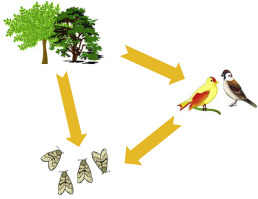当前位置:
X-MOL 学术
›
Crop Prot.
›
论文详情
Our official English website, www.x-mol.net, welcomes your
feedback! (Note: you will need to create a separate account there.)
Birds and bats contribute to natural regulation of the millet head miner in tree-crop agroforestry systems
Crop Protection ( IF 2.5 ) Pub Date : 2020-06-01 , DOI: 10.1016/j.cropro.2020.105127 Ahmadou Sow , Djiby Seye , Emile Faye , Laure Benoit , Maxime Galan , Julien Haran , Thierry Brévault
Crop Protection ( IF 2.5 ) Pub Date : 2020-06-01 , DOI: 10.1016/j.cropro.2020.105127 Ahmadou Sow , Djiby Seye , Emile Faye , Laure Benoit , Maxime Galan , Julien Haran , Thierry Brévault

|
Abstract A better understanding of environmental factors driving natural pest regulation is a major challenge for designing sustainable cropping systems. The objective of the present study was to assess the association between vegetation openness in traditional tree-crop agroforestry systems in Senegal, richness and abundance of vertebrates including insectivorous birds and bats, and their contribution to the natural regulation of crop pests. The millet head miner (MHM), Heliocheilus albipunctella (Lepidoptera, Noctuidae), a major constraint to increasing millet crop productivity in sub-Saharan Africa, was selected as a model system. Ten sites separated by at least one km from each other were selected in a 100 km2 study area in the Peanut basin in Senegal. In each site, a pair of millet fields distant from at least 100 m each was selected according to a gradient of vegetation openness within a 100-m radius buffer with sampling plot (5 × 5 m) at the center. Nine insectivorous bird and bat species were recorded in millet fields over the 2017 cropping season and their predator status was confirmed by direct observation or DNA detection in fecal samples. Grain losses were reduced when panicles were accessible to birds and bats, confirming their net contribution to pest regulation. At a local scale, tree diversity and vegetation openness were important predictors of the abundance of insectivorous village weaver birds and grey-headed sparrows, respectively. Some tree species (soapberry trees and neems) indirectly contributed to natural regulation of the MHM likely by providing refuges to insectivorous vertebrates whereas other tree species (baobabs) provided disservices as possible refuges for the MHM moths. Further research is needed to better understand relationships between tree cover, food web interactions and natural pest suppression, so that specific conservation measures such as habitat management can be designed to improve pest control.
中文翻译:

鸟类和蝙蝠有助于树木作物农林业系统中小米头矿工的自然调节
摘要 更好地了解驱动自然虫害调控的环境因素是设计可持续种植系统的主要挑战。本研究的目的是评估塞内加尔传统树木作物农林业系统的植被开放度与包括食虫鸟类和蝙蝠在内的脊椎动物的丰富度和丰度之间的关联,以及它们对作物害虫自然调节的贡献。小米头矿工(MHM),白纹夜蛾(鳞翅目,夜蛾科)是撒哈拉以南非洲提高小米作物生产力的主要制约因素,被选为模型系统。在塞内加尔花生盆地 100 平方公里的研究区域中选择了十个相距至少一公里的地点。在每个站点,根据以采样地(5×5 m)为中心的 100 米半径缓冲区内植被开放度的梯度,选择了一对距离至少 100 米的小米田。在 2017 年的种植季节,小米田里记录了 9 种食虫鸟类和蝙蝠物种,通过直接观察或粪便样本中的 DNA 检测证实了它们的捕食者状态。当鸟类和蝙蝠可以接触穗时,谷物损失就会减少,这证实了它们对害虫调控的净贡献。在局部范围内,树木多样性和植被开放度分别是食虫村织鸟和灰头麻雀数量的重要预测因子。一些树种(无花果树和印楝树)通过为食虫脊椎动物提供避难所间接促进了 MHM 的自然调节,而其他树种(猴面包树)则作为 MHM 飞蛾的可能避难所提供了损害。需要进一步研究以更好地了解树木覆盖、食物网相互作用和自然害虫抑制之间的关系,以便可以设计特定的保护措施,例如栖息地管理,以改善害虫控制。
更新日期:2020-06-01
中文翻译:

鸟类和蝙蝠有助于树木作物农林业系统中小米头矿工的自然调节
摘要 更好地了解驱动自然虫害调控的环境因素是设计可持续种植系统的主要挑战。本研究的目的是评估塞内加尔传统树木作物农林业系统的植被开放度与包括食虫鸟类和蝙蝠在内的脊椎动物的丰富度和丰度之间的关联,以及它们对作物害虫自然调节的贡献。小米头矿工(MHM),白纹夜蛾(鳞翅目,夜蛾科)是撒哈拉以南非洲提高小米作物生产力的主要制约因素,被选为模型系统。在塞内加尔花生盆地 100 平方公里的研究区域中选择了十个相距至少一公里的地点。在每个站点,根据以采样地(5×5 m)为中心的 100 米半径缓冲区内植被开放度的梯度,选择了一对距离至少 100 米的小米田。在 2017 年的种植季节,小米田里记录了 9 种食虫鸟类和蝙蝠物种,通过直接观察或粪便样本中的 DNA 检测证实了它们的捕食者状态。当鸟类和蝙蝠可以接触穗时,谷物损失就会减少,这证实了它们对害虫调控的净贡献。在局部范围内,树木多样性和植被开放度分别是食虫村织鸟和灰头麻雀数量的重要预测因子。一些树种(无花果树和印楝树)通过为食虫脊椎动物提供避难所间接促进了 MHM 的自然调节,而其他树种(猴面包树)则作为 MHM 飞蛾的可能避难所提供了损害。需要进一步研究以更好地了解树木覆盖、食物网相互作用和自然害虫抑制之间的关系,以便可以设计特定的保护措施,例如栖息地管理,以改善害虫控制。









































 京公网安备 11010802027423号
京公网安备 11010802027423号